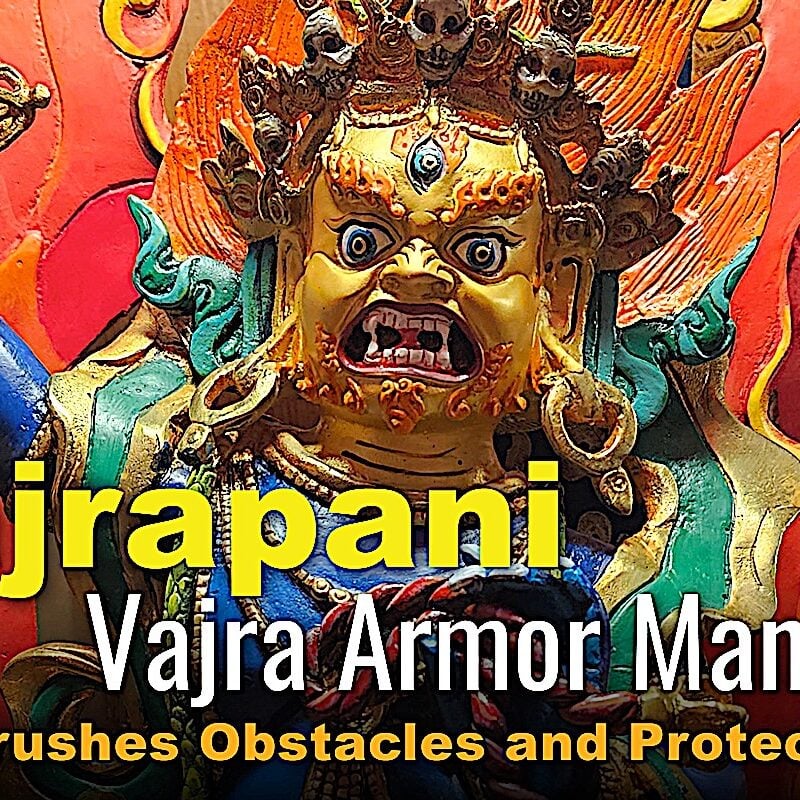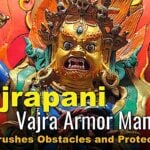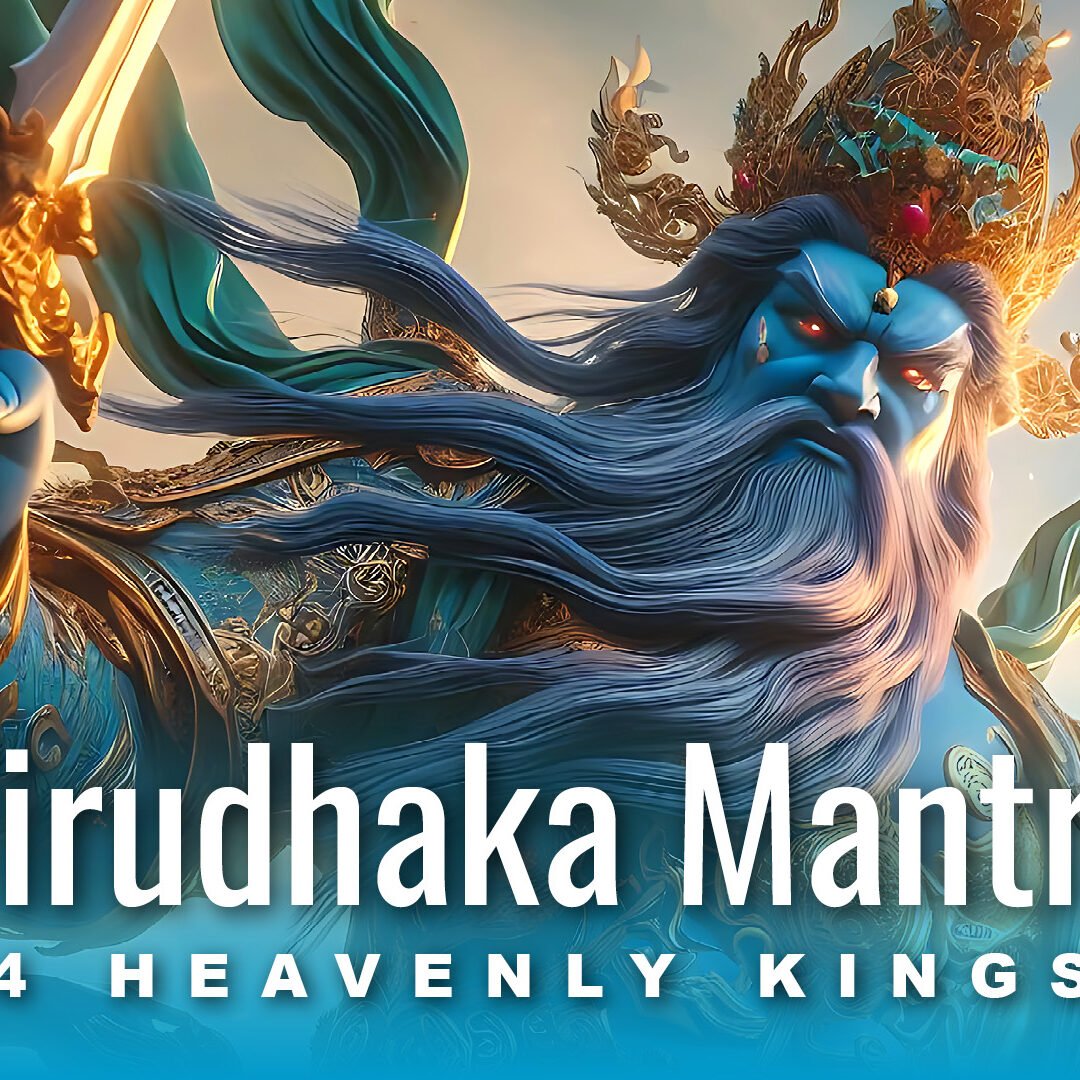Video: Lama Tsongkhapa Visualization and Practice with Migtsema Chanting
Great Sage from the Land of Snows, Lama Tsongkhapa — an ideal practice
In these difficult times, we need practices that generate the healing powers of Compassion, Wisdom and Power. These are usually personified, from a Mahayana Buddhist point-of-view in the Enlightened forms of Chenrezig for Compassion, Manjushri for Wisdom, and Vajrapani for Power. Or, in the profound practice of the Buddha from the Land of Snows, Lama Je Tsongkhapa, who is an emanation of all three.
Come along with us now as we celebrate the life and practice of the Great Sage from the Land of Snows, and finish with a visualization and chanting of the Migtsema.
In the land of snows, in the year 1357, a boy who would come to be known as Lama Tsongkhapa was born to a Mongolian father and a Tibetan mother in Amdo, Tibet. He would come to be revered as the Buddha from the Land of Snows, and an incarnation of all three of the Great Bodhisattvas: Manjushri, Avalokiteshvara and Vajrapani. His practice, today, embodies the qualities of these great ones: Wisdom, Compassion, and Power. He is equally revered for his vast library of Enlightened teachings in written form.
Lama Tsongkhapa’s birth was prophesized by both Buddha Shakyamuni and Guru Rinpoche according to texts, including the Manjushri Root Text.
Buddha Shakyamuni prophesized, “After I pass away and my pure doctrine is absent, you will appear as an ordinary being, performing the deeds of a Buddha, and establishing the Joyful Land, the great Protector, in the Land of the Snows.”
In these difficult times, many famous gurus, lamas and teachers suggest this very powerful, yet accessible practice. The practice does not require initiation or empowerment—although the guidance of a teacher and initiation are beneficial.
Kyabje Lama Zopa Rinpoche advised: “If one keeps even a drop of the nectar of the name of this holy being Lama Tsongkhapa in a devotional heart, it plants the seed of liberation and one receives the fortune to practice and enjoy happiness from this life up to enlightenment.”
Historically, Lama Tsongkhapa is among the greatest of the sages of the Land of Snows. He authored numerous exhaustive and profound texts covering everything from Lamrim to Secret Tantra — all of the key teachings of sutra and tantra combined.
The great sage Lama Tsongkhapa taught extensively on Shunyata, on Emptiness. He famously wrote: “Emptiness is the track on which the centered person moves.” He always emphasized logic and philosophy and debate — as could be expected from an emanation of Manjushri. Ultimate truth and Shunyata were a central focus to many of his writings — and he was especially focused on overcoming the various misinterpretations of Emptiness, especially incorrect Nihilisitic and Absolutist views.
Lama Tsongkhapa asserted authoritatively that all phenomena are empty of inherent existence or essence — in Sankrit svabhava — because they are dependently originated.
Join Lee Kane, now, for a quick guided practice in Lama Tsongkhapa.
Daily Lama Tsonkhapa Practice for Compassion, Wisdom and Power
Daily Lama Tsongkhapa’s Guru Yoga makes it easier for us to develop compassion, and let go of anger. Tsongkhapa practice, with focus, is a wisdom and a power practice. It is a short practice, ideal for busy people with little time to meditate.
The Migtsema mantra can also be spoken and visualized by anyone for great benefits:
MIG MEY TZE WAY TER CHEN CHENREZIG
DRI MEY KHYEN PI WANG PO JAMPAL YANG
DU PUNG MA LU JOM DZEY SANG WEY DAG
GANG CHENG KE PEY TSUG GYEN TSONGKHAPA
LO SANG TRAG PEY SHAB LA SOL WA DEB
This can also be spoken in English, although it tends to be easier to memorize, chant and empower in the Tibetan. The English reads as:
Objectless compassion, Chenrezig
Lord of stainless wisdom, Manjushri,
Conquering mara’s hordes, Vajrapani,
Crown jewel of the Sages of the Land of Snows, Tsongkhapa,
Losang Drakpa, at your feet, I prostrate
A Simple Practice Containing All 84,000 Teachings of Lord Buddha
The short Guru Yoga of Lama Tsongkhapa, on one level, contains entire teachings of Lord Buddha. As the practice is short, it is easy to memorize, and quick to practice — ten minutes from beginning to end.
In the very precious Tibetan Buddhist tradition, practices always incorporate all three of the body, speech and mind.
For body, we might fold our hands in prayer, bow, or make a symbolic mudra (hand gesture) for offerings.
For speech, we say the words of praise, the vows of Bodhichitta, and the mantras which help focus our minds
For mind, especially in Tibetan tradition, we visualize or imagine the Buddha in our minds, and also try to keep that visualization and the practice in context with the concept of wisdom
First, Refuge: we always take refuge in the three jewels: Buddha Dharma, and Sangha.
Then, because this is a Mahayana practice, the Bodhichitta vow: the most precious promise to benefit all sentient beings.
Next, because Lama Tsonkhapa embodies compassion, state the Immeasurable Attitudes: aspirations for the benefit of al all beings.
Visualization engages our mind and imagination, as we picture the entire limitless merit field of Buddhas, Bodhisattvas, and Gurus, with Lama Tsongkhapa at the summit of the merit field.
Seven Limbed Prayer: prostrations, offerings, declarations, rejoicing, requesting teachings, requesting Lama Tsongkahapa remain with us always, and a dedication.
Offering: in this case a short mandala offering
Mantra: spoken and visualized: often visualizing healing light from Lama Tsonkhapa going out to all sentient beings and easing their suffering.
Final Dedication: all Tibetan practices always dedicated the merit of the virtue of the practice to the cause for Enlightenment for the benefit of all sentient beings.
Say three times:
I take refuge in the Buddha, the Dharma, and the Sangha,
Until I attain enlightenment.
By the merit accumulated from practicing generosity and the other perfections,
May I attain Enlightenment in order to benefit all sentient beings.
Cultivating Four Immeasurable Attitudes
Say three times:
May all beings have happiness and its causes,
May all beings be freed from suffering and its causes;
May all beings constantly dwell in joy transcending sorrow;
May all beings dwell in equal love for those both near and far.
Visualization and Practice
Speak aloud and visualize:
From the heart of the Protector of the hundreds of deities of the the Joyful Land,
To the peak of a cloud which is like a cluster of fresh, white curd,
All-knowing Losang Dragpa, King of the Dharma,
Please come to this place together with your two chief disciples.
In the space before me on a lion throne, lotus, and moon,
The Venerable Gurus smile with delight.
Supreme Field of Merit for my mind of faith,
Please remain for a hundred aeons to spread the teaching.
Seven-Limbed Prayer
Now that you’ve invited and visualized, perform the seven-limbed prayer with all your heart:
Prostrations
Your minds of wisdom realize the full extent of objects of knowledge,
Your eloquent speech is the ear-ornament of the fortunate,
Your beautiful bodies are ablaze with the glory of renown.
I prostrate to you, whom to see, to hear, and to remember is so meaningful.
Offerings
Pleasing water offerings, various flowers,
Sweet-smelling incense, lights, scented water and so forth,
A vast cloud of offerings both set out and imagined,
I offer to you, Supreme Field of Merit.
Declarations
Whatever non-virtues of body, speech and mind
I have accumulated since time without beginning,
Especially transgressions of my three levels of vows,
With great remorse I declare each one from the depths of my heart.
Rejoicing
In this degenerate age you strove for much learning and accomplishment.
Abandoning the eight worldly concerns, you made your leisure and endowment meaningful.
Protector, from the very depths of my heart,
I rejoice in the great wave of your deeds.
Request for Dharma Teachings
From the billowing clouds of wisdom and compassion
In the space of your Enlightened minds, venerable and holy Gurus,
Please send down a rain of vast and profound Dharma
Appropriate to the disciples of this world.
Request to Remain
May your Vajra Body, created from the purity of clear light,
Free of the rising and setting of cyclic existence,
But visible to the ordinary viewer only in its unsubtle, physical form,
Stay on unchanging, without waning, until samsara ends.
Dedication
Through the virtues I have accumulated here,
May the teachings and all living beings receive every benefit. Especially may the essence of the teaching
Of Lama Je Tsong Khapa shine forever.
More articles by this author

VIDEO: Vajrapani Vajra Armor Mantra: Supreme Protection of Dorje Godrab Vajrakavaca from Padmasambhava

Buddhist body mandala practice in Vajrayana Buddhism — and riding the winds of the inner body “The prana goes where the mind goes.””
Search
Latest Features
Please support the "Spread the Dharma" mission as one of our heroic Dharma Supporting Members, or with a one-time donation.
Please Help Support the “Spread the Dharma” Mission!

Be a part of the noble mission as a supporting member or a patron, or a volunteer contributor of content.
The power of Dharma to help sentient beings, in part, lies in ensuring access to Buddha’s precious Dharma — the mission of Buddha Weekly. We can’t do it without you!
A non-profit association since 2007, Buddha Weekly published many feature articles, videos, and, podcasts. Please consider supporting the mission to preserve and “Spread the Dharma." Your support as either a patron or a supporting member helps defray the high costs of producing quality Dharma content. Thank you! Learn more here, or become one of our super karma heroes on Patreon.
Lee Kane
Author | Buddha Weekly
Lee Kane is the editor of Buddha Weekly, since 2007. His main focuses as a writer are mindfulness techniques, meditation, Dharma and Sutra commentaries, Buddhist practices, international perspectives and traditions, Vajrayana, Mahayana, Zen. He also covers various events.
Lee also contributes as a writer to various other online magazines and blogs.
















